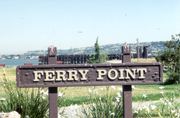A Regional Plan Is the Best Plan for Ferry Service

Published: August, 2001
Before there were bridges to cross San Francisco Bay and the Delta waterways and highways to carry vehicles from the East Bay westward, ferries were the preferred method of transportation.
Today, as longer commute hours offer up pictures in slow motion of freeways and highways clogged with cars, a water-borne transportation system seems an attractive alternative.
In the Delta-North Bay area Martinez, Crockett, Rodeo and Benicia, cities on either side of the Carquinez Strait, served as ferry terminals long before the steel was forged for the Benicia-Martinez and Carquinez bridges and the concrete poured to construct Interstates 80 and 680.
The Vision and Conceptual Design for a Bay Area High-Speed water Transit System, completed by the Water Transit Initiative Task Force, the precursor to the San Francisco Water Transit Authority (WTA), released in February 1999, envisioned an initial, critical mass phasing that would include both the cities with already established ferry service, such as Vallejo and Richmond, as well as cities planned for Phase I water transit terminals such as Benicia and Martinez. They are considered "first-tier cities."
Officials of these municipalities agree that a regional approach is the most expedient manner of addressing the issue.
"The per passenger cost of ferry operations is quite high. You need a strong ridership and an operations subsidy to keep a ferry service viable," said Contra Costa County Supervisor John Gioia, the county’s representative to the WTA. "San Francisco Bay ferry service is a regional issue. Locations need to be selected that would attract the most riders and help the community in which the ferry terminal is located, and the region as well. It needs to be decided on a regional basis."
Gioia, an attorney and Richmond resident, handled some of the legal transactions involving land use between the city and the Red and White Fleet, which operated ferry service between Richmond and San Francisco for several months last year.
"Clearly, there were not enough riders and the ferry service was a bit premature in its timing. There is a lot of new development on the Richmond waterfront, with biotech and high tech companies locating there. There will be lots of new jobs as a result and an explosion of new housing at the marina. What you will have is a reverse commute, with people coming from San Francisco to work in those news jobs.
"Additionally, there was no operational subsidy. It was the only one operating in the Bay Area without a subsidy", Gioia noted.
Other contributing factors, he suggested, were time/speed and marketing. It took 45-minutes to cross the Bay between the two cities, a commute that would be shortened by a faster boat which would help a ferry commute more attractive. Additionally, better marketing was needed.
"I really believe that, at least in the case of Richmond, a faster boat, an operating subsidy and better timing would have helped and would help in the future," said Gioia.
The second phase of the plan envisions potentially adding the cities of Antioch and Pittsburg and the unincorporated communities of Crockett and Rodeo. These are considered "second tier" communities, with ferry service envisioned at 10 years or more down the road.
Pittsburg currently does not have plans for a ferry terminal, according to city officials. Antioch, which has major plans for its downtown and waterfront area, is interested and its long-term marina plans call for a ferry pier.
Appointed to the WTA a few months ago as the representative of the City of Antioch, City Council Member Arne Simonsen is still quite new to the idea. He has not had the opportunity to meet with the representatives from the other cities to even begin discussing how his city would fit into the plan.
"Antioch was not even listed on the original map that indicates where ferry service might be located," Simonsen said. "I think a survey should be conducted among Antioch residents to see if they are interested in a ferry service."
Although ferries plied the waters between Martinez and Benicia in the mid-1800s, carrying men en route to the Gold County to seek their fortunes, with the construction of bridges and increased vehicular traffic, none have done so for many years.
The City of Benicia is not interested in a ferry terminal due to its proximity to Vallejo, and is concentrating instead on developing a new Intermodal that will include train and bus service.
Envisioned by city leaders as a destination spot for local and regional residents, the city-owned Martinez Marina is undergoing a major refurbishing. Located near the marina, a new Intermodal facility that is expected to open within a few months would tie land and water transportation together. The city currently does not have the funding for a ferry terminal, however.
"Anything that would enhance ferry service in San Francisco Bay should be explored," said Nello Bianco, the newly appointed representative to the WTA from the City of Martinez.
A number of Vallejo residents currently commute to and from San Francisco on large high-speed catamarans.
"The more types of public transportation that are available the better," said Pam Belchamber, transportation superintendent for the City of Vallejo.
"The goal of the WTA is to look at all the work that has to be done around the San Francisco Bay Area from a transportation standpoint, including more bus and rail service," Belchamber noted. "Looking at ferries in isolation has not been Vallejo’s approach.
"Martinez," she said, "is probably a viable location for a ferry as it is not too close to BART. At what point and to what degree is the point. That’s the charge of the WTA. As much as Vallejo and Solano County residents would love to have BART, it is not in our immediate future. The ferry is our BART," Belchamber said.

